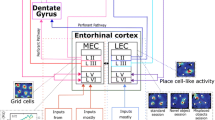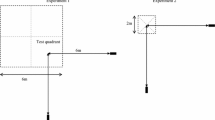Abstract
The aim of spatial orientation studies is to determine what information controls the subject’s orientation in space and how this information is integrated and organized. In the ethological approach of this field of research, the first step always consists of defining the cues which a particular species uses in a given situation on the basis of its sensory equipment and with respect to the requirements it has to fulfill in its natural way of life. At this point in our investigations we have not only to ask what sensory modalities are involved, but, more fundamentally, whether our subjects rely on information which is registered “on site”, i.e. at particular locations or whether they use information which has been generated “en route”, i.e. during a preceding phase of locomotion (Baker, 1981;1984; Mittelstaedt and Mittelstaedt, 1982). Adopting the terminology which R. Robin Baker has coined with respect to navigation (usually defined in the ethological literature as goal-directed orientation across unfamiliar space), we shall refer to these two categories of spatial information as “location-based” and as “route-based” information.
Access this chapter
Tax calculation will be finalised at checkout
Purchases are for personal use only
Preview
Unable to display preview. Download preview PDF.
Similar content being viewed by others
References
Baker, R.R., 1981. “Human navigation and the sixth sense”. Hodder and Stoughton, London, Sidney, Auckland, Toronto.
Baker, R.R., 1984. “Bird Navigation”. Hodder and Stoughton, London, Sidney, Auckland, Toronto.
Barlow, J.S., 1964. Inertial Navigation as a Basis for Animal Navigation J. Theor. Biol. 6: 76–117.
Batschelet, E., 1981. “Circular Statistics in Biology ”. Academic Press, New York.
Bovet, J., 1978. Homing in Wild Myomorph Rodents: Current Problems. Ins “Animal Migration, Navigation and Homing”. K. Schmidt-Koenig and W.T. Keeton (Eds.), Springer Verlag, Berlin, Heidelberg, New York.
Bovet, J., 1984. Strategies of homing behavior in the red squirrel, Tamiasciurus hudsonicus. Behavioral Ecology and Sociobiology, 16: 81–88.
Etienne, A.S., 1980. The orientation of the golden hamster to its nest-site after the elimination of various sensory cues. Experientia, 36, 1048–1050.
Etienne, A.S., Teroni, E., Maurer, R., Portenier, V., Saucy, F., 1985 Short-distance homing in a small mammal: the role of exteroceptive cues and path integration. Experientia, 41: 122–125.
Etienne, A.S., Maurer, R., Saucy, F., Teroni, E., 1906. Short-distance homing in the golden hamster after a passive outward journey. Animal Behavior. In press.
Gould, J.L., 1982. The map sense of pigeons. Nature, 296: 205–211.
Graue, L.C., 1963. The effect of phase shifts in the day-night cycle on pigeon homing at distances of less than one mile. Ohio J. Science, 63: 214–217.
Mather, J.F., Baker, R.R., 1981. Magnetic sense of direction in woodmice for route-based navigation. Nature, 291: 152–155.
Mayne, R., 1974. A Systems Concept of the Vestibular Organs. In: “Handbook of Sensory Physiology VI/2, Vestibular System, Part 2: Psychophysics, Applied Aspects and General Interpretations”. H.H. Kornhuber (Ed.), Springer, Berlin, Heidelberg, New York.
Mittelstaedt, H., 1978. Analyse von Orientierungsleistungen. In “Kybernetik 1977”. G. Hauske und E. Butenandt (Eds.), R. Oldenbourg, München, Wien.
Mittelstaedt, H. and Mittelstaedt, M.-L., 1932. Homing by Path Integration. In: “Avian Navigation”, F. Papi and H.G. Wallraff (Eds.), Springer, Berlin, Heidelberg, New-York.
Olton, D.S., 1979. Mazes, Maps and Memory. American Psychologist, 34: 583–596.
O’Keefe, J. and Nadel, L., 1978. “The Hippocampus as a Cognitive Map”. Clarendon Press, Oxford.
Potegal, M., 1982. Vestibular and Neostriatal Contributions to Spatial Orientation. In: “Spatial Abilities. Development and Physiological Foundations”. M. Potegal (Ed.). Academic Press, London, New York.
Schöne, H., 1980. “Orientierung im Raum”. Wissenschaftliche Verlagsgesellschaft MBH, Stuttgart.
Wallraff, H.G., 1974. “Das Navigationssystem der Vögel”. Schriftenreihe Kybernetik. H. Marko and H. Mittelstaedt (Eds.). R. Oldenbourg, München, Wien.
Wehner, R., 1982. “Himmelsnavigation bei Insekten”. Neujahrsblatt, Naturforschende Gesellschaft in Zürich ( Ed.) Orell Füssli, Zürich.
Wehner, R. and Flatt, I., 1972. The Visual Orientation of Desert Ants, Cataglyphis bicolor, by Means of Terrestrial Cues. In: “Information Processing in the Visual Systems of Arthropods”. Wehner, R. (Ed.) Springer, Berlin, Heidelberg, New York.
Wiltschko, W. and Wiltschko, R., 1976. Interrelation of Magnetic Compass and Star Orientation in Night-migrating Birds. Journal Comparative Physiology, 109: 91–99.
Wiltschko, W. and Wiltschko, R., 1978. A theoretical model for migratory orientation and homing in birds. Oikos, 30: 177–187.
Wiltschko, R. and Wiltschko, W., 1981. The Development of Sun Compass Orientation in Young Homing Pigeons. Behavioral Ecology and Sociobiology, 9: 135–141.
Author information
Authors and Affiliations
Editor information
Editors and Affiliations
Rights and permissions
Copyright information
© 1987 Martinus Nijhoff Publishers, Dordrecht
About this chapter
Cite this chapter
Etienne, A.S. (1987). The Control of Short-Distance Homing in the Golden Hamster. In: Ellen, P., Thinus-Blanc, C. (eds) Cognitive Processes and Spatial Orientation in Animal and Man. NATO ASI Series, vol 36. Springer, Dordrecht. https://doi.org/10.1007/978-94-009-3531-0_19
Download citation
DOI: https://doi.org/10.1007/978-94-009-3531-0_19
Publisher Name: Springer, Dordrecht
Print ISBN: 978-94-010-8078-1
Online ISBN: 978-94-009-3531-0
eBook Packages: Springer Book Archive




